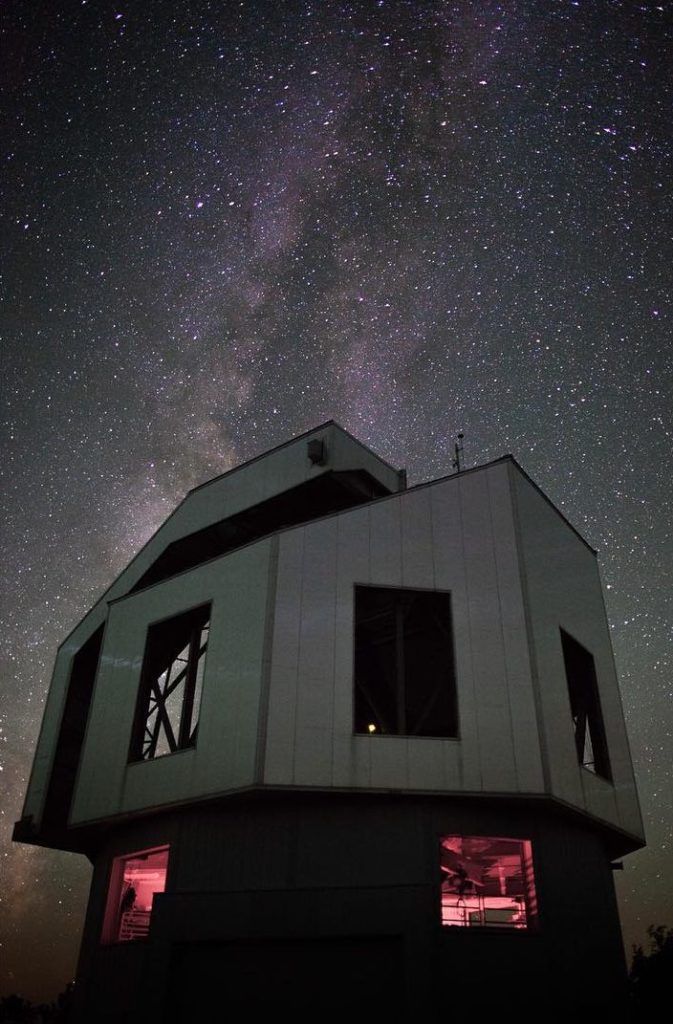
Lowell Discovery Telescope framed by the Milky Way. Credit: Joe Llama
Flagstaff, AZ. – On the night of May 18, Lowell Observatory resumed science operations with the Lowell Discovery Telescope. This capped a week of testing new, COVID-19-deterring procedures. Observatory staff took advantage of the apparition of Comet ATLAS (C/2019 Y4) to test these procedures and capture images of this fragmenting comet.
Lowell Observatory closed the 4.3-meter Lowell Discovery Telescope (LDT, formerly known as the Discovery Channel Telescope) on March 31 in response to the COVID-19 pandemic. During the ensuing weeks of telescope closure, Lowell staff developed new measures intended to allow safe operation of the LDT. They focused on implementing appropriate social distancing practices that will limit the potential spread of infectious diseases such as COVID-19.
Members of Lowell’s technology group, as well as the observatory’s safety committee, worked with medical professionals to establish the new protocols. One key element ensures that telescope operators receive the technological and logistical support necessary to operate the LDT safely. Another measure allows for engineers working during the day to keep the facility running while maintaining appropriate distance from one another and from the night operations staff.
Kyler Kuehn, Lowell Observatory’s Deputy Director for Technology, said, “Our team worked very hard to ensure the safety of all of our staff and potential visiting astronomers, while still allowing us to do as much observing as possible. We’re especially grateful for the input from members of the Flagstaff medical community on this new plan for safe operations.”
On May 11, engineering and instrumentation staff began a week of testing the new procedures while operating the telescope and its instruments under expected-use conditions. This included observing an astronomical object, for which they chose Comet ATLAS (C/2019 Y4).
Comet ATLAS (C/2019 Y4)
Comet ATLAS (C/2019 Y4) was discovered late in 2019. It had been brightening rapidly and was widely anticipated to become a potentially spectacular naked-eye object before unexpectedly beginning to break up in late March.
The new comet images taken during the LDT testing week reveal that multiple fragments of the comet remain and continue to produce new gas. The last of the LDT images was captured when Comet ATLAS was less than 35 degrees away from the Sun, as seen from Earth. This demonstrated the value of the LDT for such observations and the timing of getting the telescope back in operations.
LDT Scientist Stephen Levine said, “From a scientific perspective, Comet ATLAS is a timely target. From a telescope operations perspective it was very useful, allowing us to successfully test several of the LDT’s more complex modes of operation.”
With the COVID-19 protocols successfully checked out, the LDT resumed science observations on May 18. Lowell Observatory Director Jeff Hall said, “Like everyone, we want to get back to work and get our lives and our mission back into gear. But we must do that in a manner that is safe and respectful to our staff, residents of our community, and our guests. It’s great to see LDT up and running, and we look forward to the same for the rest of our programs as soon as we can safely do so.”
*Note: While Lowell Observatory is beginning to resume science operations, all public facilities remain closed and will likely not reopen for at least several weeks. The observatory will update this status through its website and social media channels when conditions change.
###
Media Contact
Kevin Schindler, Lowell Observatory
(928) 607-1387
kevin@lowell.edu
###
Links
Video – Lowell Discovery Telescope, dome exterior (Credit: Harun Mehmedinovic/SKYGLOW Project): https://youtu.be/T9a–WgZEb8
Video – Lowell Observatory Telescope, dome interior (Credit: Harun Mehmedinovic/SKYGLOW Project): https://youtu.be/9r3IgWIMrv8
Comet ATLAS observation blog: https://lowell.edu/lowell-discovery-telescope-resumes-science-observations-and-comet-atlas-c-2019-y4/
###
About Lowell Observatory
Lowell Observatory is a private, nonprofit 501(c)(3) research institution, founded in 1894 by Percival Lowell atop Mars Hill in Flagstaff, Arizona. The observatory has been the site of many important discoveries, including the first detection of large recessional velocities (redshift) of galaxies by Vesto Slipher in 1912-1914 and Clyde Tombaugh’s discovery of Pluto in 1930. Today, the observatory’s 14 tenured astronomers use ground-based telescopes around the world, telescopes in space, and NASA planetary spacecraft to conduct research in diverse areas of astronomy and planetary science. Lowell Observatory currently operates multiple research instruments at its Anderson Mesa station, east of Flagstaff, and the 4.3-meter Lowell Discovery Telescope near Happy Jack, Arizona. The observatory also welcomes more than 100,000 guests per year to its Mars Hill campus in Flagstaff, Arizona, for a variety of educational experiences, including historical tours, science presentations, and telescope viewing.